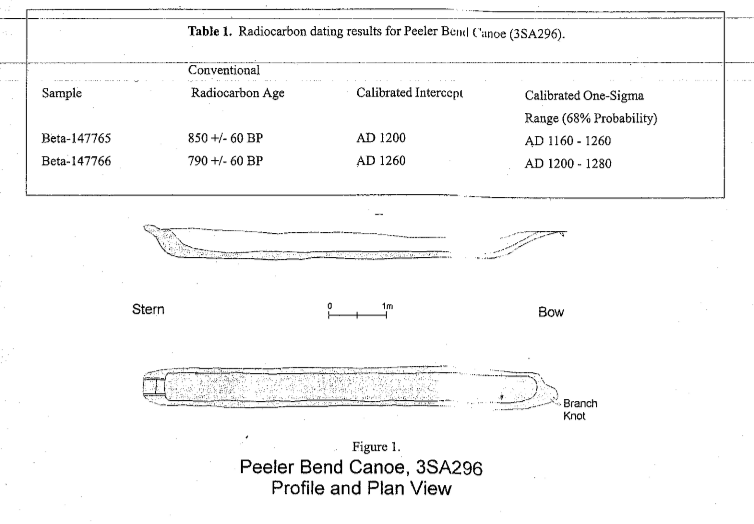By Kathryn Bryles, Graduate Assistant

Photo credit: Encyclopedia of Arkansas
While he was fishing along the Saline River in August of 1999, Charles Greene of Benton spotted something unusual in the water near a sand bar. Greene first thought he had found a big piece of petrified wood, but closer inspection revealed it was a huge dugout canoe. Now called the Peeler Bend Canoe, it is one of only two prehistoric dugout canoes ever discovered in Arkansas. The Griggs Canoe, also found in the Saline River, is housed at the Toltec Mounds Archaeological State Park. Both canoes are part of an extensive archaeological and historical record associated with the Caddo and Quapaw tribes. These objects are important examples of Arkansas’s Native American heritage, offering insight into the lives of indigenous people who depended on the Saline River for food and transportation.
Written record of dugout canoes in Arkansas date back to the expedition of Hernando de Soto. On May 22, 1541, when Spanish explorers crossed into the province of Aquixo, once located south of Memphis on the Arkansas side of the Mississippi River, de Soto wrote that a fleet of 200 dugout canoes arrived to meet his army. Each canoe was loaded with Native American warriors wearing body paint and colorful feathered regalia.
Dugout canoes created before European contact offer a rare look at the transportation technology used by early Arkansas tribes. Canoes were often a tribe’s quickest and easiest means of movement, and they allowed indigenous people to travel long distances for purposes including trade, hunting, and tribal conflict. Construction of a single canoe took many days and a massive amount of labor. Most canoes were twenty to thirty feet long and weighed over one thousand pounds. First, a group of people worked together to fell a large tree and remove the bark. Next, fires lit along the newly exposed surface softened the trunk. Finally, members of the tribe used stone tools to hollow out and shape the log as low fires continued to burn.

Photo credit: Mary Beth Trubitt, "Update on the Peeler Bend Canoe."
The dugout canoe discovered by Charles Greene in 1999 took its name from the Peeler Bend on the Saline River, near where it was found. Carved from yellow pine, the Peeler Bend Canoe measures twenty-four feet long and twenty-six inches wide. A large stone was also found with the canoe; worn grooves along the surface of the stone suggest that ropes were once wrapped around it, indicating that the stone was probably used as an anchor. After excavating it from the Saline River, archaeologists temporarily sunk the Peeler Bend Canoe in a nearby pond before bringing it to Historic Arkansas Museum in 2001, where expert conservator Andrew Zawacki preserved it by submerging it in a huge tank of water and polyethylene glycol (PEG) for over a year. The PEG solution slowly replaced water in the wood’s cellular structure, which prevented the canoe from drying out and collapsing upon removal from the tank. Radiocarbon dating suggests the canoe is around 800 years old, which means it was made between 1160 and 1300 CE, at least 200 years before Hernando de Soto arrived at Aquixo. The Peeler Bend Canoe is currently on display in the River Center at Riverside Park in Benton, on loan from the Arkansas Department of Parks, Heritage and Tourism. It serves as a remarkable reminder of the people who once called the Saline River home.
References
Mary BethTrubitt, "Update on the Peeler Bend Canoe: An Ancient Dugout Canoe from Saline County," Field Notes, Newsletter of the Arkansas Archeological Society, No. 307, July/August 2002.
Cody Lynn Berry, "Peeler Bend Canoe," Encyclopedia of Arkansas, https://encyclopediaofarkansas.net/entries/peeler-bend-canoe-12502/ accessed April 13, 2020.
Jeffrey M. Mitchem, "A Mississippian Dugout Canoe from Northeast Arkansas," presented at 66th Annual Meeting of Southeastern Archaeological Conference, November 6, 2009.
Arkansas Natural and Cultural Resources Council Grant Purchase files Historic Arkansas Museum Object File.
Conservation Report, Andy Zawacki.
.jpg?sfvrsn=34a692c5_1&MaxWidth=510&MaxHeight=300&ScaleUp=false&Quality=High&Method=ResizeFitToAreaArguments&Signature=9DA6BCDA0F6375C2FC2F0FA31775DC1EC59D6802)